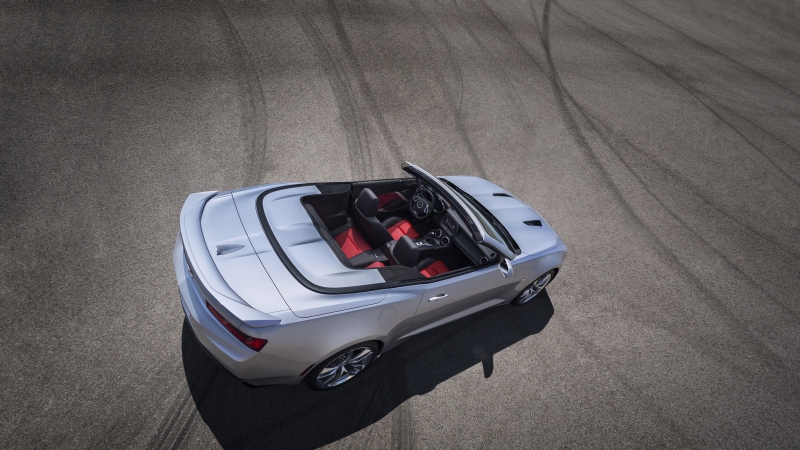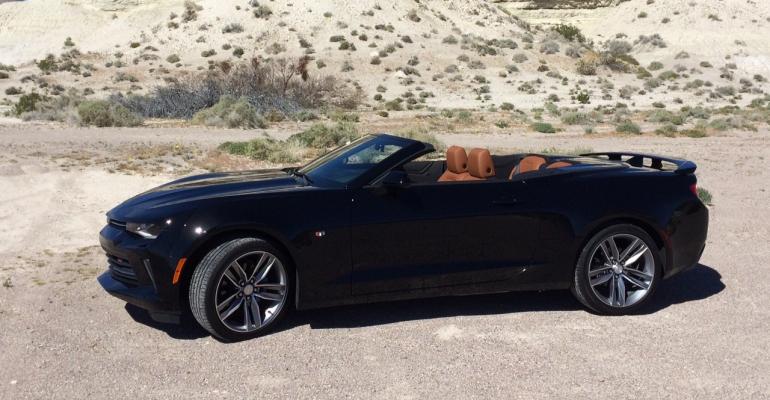DEATH VALLEY JUNCTION, CA – General Motors expands the redesigned ’16 Chevy Camaro lineup with a convertible model that makes top-down pony-car driving downright enjoyable, and outfits entry-level models with a potent but fuel-efficient 4-banger to widen the appeal of the 2-door.
There will be those coupe purists who sneer at the idea of a convertible sports car, and others who consider a 4-cyl. in an American muscle car an indignity. But after a dose of track time and close to 200 miles (322 km) of open-road testing in both models, which arrive at Chevy dealerships just in time for summer, it’s easy to see GM did its homework on these variants rather than re-engineer after the fact to make them simply passable.
The longtime problem with most convertibles, of course, is once the top gets chopped off a hefty crossbeam usually is added to keep its cowl from shakin’ like Rosanna. Smooth it out too much and it goes from a sports car to boulevard cruiser.
And let’s face it, for being topless, a lot of convertibles are not much to look at.
But this Camaro convertible is a different breed. It owes its refinement to a modular body structure, which allows engineers to tailor the chassis to each specific model – from the convertible and 4-cyl. driven here to the coming ZL1 super-Camaro.
The new Camaro 1SS convertible sheds about 275 lbs. (125 kg) from the model it replaces, as the car in general uses a heavy dose of aluminum for structural and suspension parts. Add in the Camaro’s shrunken dimensions, and the convertible has the same pinpoint handling and “tossability” of the coupe. For a convertible, the Camaro provides a tremendously composed, predictable ride and easily takes down desert switchbacks along the California-Nevada border.
The Camaro convertible also looks good, whether the top is up or down, because the design closely resembles the roof of the coupe. It folds cleanly into the body of the car and, unlike previous iterations, a hard tonneau cover provides a finished appearance. The roof folds relatively quickly, too, and at speeds of up to 30 mph (48 km/h). It will fold remotely from a button on the key fob.

Since the sixth-gen spent 350 hours in GM’s wind tunnel to optimize its aerodynamics, wind noise is held in check when the top is down. Passengers don’t strain to hold a conversation while cruising at Camaro-like speeds, and a few hours behind the wheel won’t deliver you windblown to your destination.
When the top is up, GM says, a multi-layered construction with acoustic and thermal barriers keeps passengers comfortable whatever the weather conditions. We’ll have to verify that claim another time because, frankly, no one with an ounce of common sense would dare block out a second of the sunny, deep blue sky here with a roof over their heads.
The open vistas the Camaro convertible provide also go a long way toward solving arguably the car’s greatest drawback – miserable sight lines due to the coupe’s slammed greenhouse.
Fortunately, there’s a standard rear-vision camera and available active safety items such as rear-park assist, rear cross-traffic alert and side blindspot alert for a boost of confidence during aggressive driving.
Death Valley also is where cell phone reception goes to die, which makes it the first spot in America we’ve found where GM’s 4G LTE wireless hotspot does not work.
Embrace The Four, Luke
Some diehards may consider the Camaro hands-off when it comes to the downsizing trend, but that’s the reality of today’s federal fuel-economy environment. Besides, although the heart and soul of the car always has been tied to eight glorious pistons, the V-6 dominates engine installations on the car at 78.4%.
And with the promise of more than 30 mpg (7.8 L/100km) highway, the 4-cyl. gives the Camaro a conscience. Yes, you can have fuel efficiency and lights-out performance in one package.
The turbocharged 2.0L Ecotec 4-cyl. certainly is no limp-wristed Iron Duke of the 1980s. Unlike that forgettable Camaro 4-banger, today’s Ecotec delivers a playful 275 hp. In fact, the Camaro 4-cyl. matches the output of the ’93-’95 Z28 with a 5.7L V-8.
The car’s 0-60 mph (97 km/h) time of 5.4 seconds also is comparable to the old Z28, while its fuel-economy numbers aren’t even worth dusting off old spec books for comparison.
However, flogging the 4-cyl. Camaro through the desert, we never sniffed 30 big ones, let alone much over 20 mpg (11.7 L/100 km). There was a warm glow in our hearts knowing we could save some serious fuel if we chose to, but then we put the hammer down and kept it there for mile after high-speed-mile on what locals call the American autobahn.
A 15-year bloom on the cacti here ratchets up the drive to epic proportions, something even the swarm of tourists in their slow-moving RVs could not ruin. We happily downshifted our 6-speed manual for a gob of the Ecotec’s 295 lb.-ft. (400 Nm) of torque and overtook them with ease.
The Ecotec LTG 4-cyl. also sees duty in the Cadillac ATS sports sedan and coupe and the Chevy Malibu midsize sedan, bowing as an all-new architecture in 2013. Other applications include the Cadillac CTS and CT6, as well as the Buick Regal and Regal GS. It earned back-to-back Wards 10 Best Engines awards in 2012 and 2013, when it boasted the most torque per liter among 4-cyl. mills on the market.

But its lineage combining gasoline direct injection, forced induction and variable valve timing dates back as far as the original Ecotec family of large-displacement 4-cyl. engines, one of them among the first to break the 130 hp/L threshold in the Pontiac Solstice GXP and Saturn Sky Redline small roadsters and convertibles in 2007. Its durability, GM says, was proved via a successful front-wheel-drive drag-racing program during the same period.
Convertible sports cars are not for everyone, evidenced by a 17.4% take rate on the previous-generation Camaro last year and 21% for the Ford Mustang, according to WardsAuto data. But new lightweight and advanced high-strength materials are making them a bit more palatable, even for the steadfast fixed-roof crowd.
But an inline-4 sports car may be a different matter. The 2.3L 4-cyl. in the Mustang, which Ford markets as a step above the entry-level V-6, was installed on 34% of its builds last year. In the Camaro, the Ecotec will be the base engine for a few hundred dollars less than the model it replaces. That should draw just as many, or likely more, takers than its rival.
So it truly is a new generation in the segment, where buyers can have their cake and eat it too – topless if they prefer.
'16 Chevy Camaro 4 Cyl. Specifications
| Vehicle type | Front-engine, RWD 4-passenger convertible |
| Engine | 2.0L turbocharged Ecotec 4-cyl. with direct injection, aluminum head and block |
| Power (SAE net) | 275 @ 5,600 rpm |
| Torque | 295 l.-ft. (400 Nm) @ 3,000-4,500 rpm |
| Bore x stroke (mm) | 88 x 88 |
| Compression ratio | 9.5:1 |
| Transmission | 6-speed manual |
| Wheelbase | 110.7 ins. (2,811 mm) |
| Overall length | 188.3 ins. (4,784 |
| Overall width | 74.7 ins. (1,897 mm) |
| Overall height | 53.1 ins. (1,348 mm) |
| Curb weight | 3,354 lbs. (1,521 kg) |
| Price as tested | $26,695 |
| Fuel economy | 21-30 mpg city/hwy (11.2-7.8 L/100 km) |
| Competition | Ford Mustang, Dodge Challenger |
| Pros | Cons |
|---|---|
| Refined top-down driving | Coupe still preferred |
| Tonneau cover improves looks | Topless market tiny |
| I-4 standout performer | Heavy foot limits efficiency |




